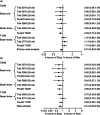Hypoglycaemia risk with insulin degludec compared with insulin glargine in type 2 and type 1 diabetes: a pre-planned meta-analysis of phase 3 trials
- PMID: 23130654
- PMCID: PMC3752969
- DOI: 10.1111/dom.12032
Hypoglycaemia risk with insulin degludec compared with insulin glargine in type 2 and type 1 diabetes: a pre-planned meta-analysis of phase 3 trials
Abstract
Aim: Hypoglycaemia and the fear of hypoglycaemia are barriers to achieving normoglycaemia with insulin. Insulin degludec (IDeg) has an ultra-long and stable glucose-lowering effect, with low day-to-day variability. This pre-planned meta-analysis aimed to demonstrate the superiority of IDeg over insulin glargine (IGlar) in terms of fewer hypoglycaemic episodes at equivalent HbA1c in type 2 and type 1 diabetes mellitus (T2DM/T1DM).
Methods: Pooled patient-level data for self-reported hypoglycaemia from all seven (five in T2DM and two in T1DM) randomized, controlled, phase 3a, treat-to-target trials in the IDeg clinical development programme comparing IDeg once-daily (OD) vs. IGlar OD were analysed.
Results: Four thousand three hundred and thirty subjects (2899 IDeg OD vs. 1431 IGlar OD) were analysed. Among insulin-naïve T2DM subjects, significantly lower rates of overall confirmed, nocturnal confirmed and severe hypoglycaemic episodes were reported with IDeg vs. IGlar: estimated rate ratio (RR):0.83[0.70;0.98](95%) (CI) , RR:0.64[0.48;0.86](95%) (CI) and RR:0.14[0.03;0.70](95%) (CI) . In the overall T2DM population, significantly lower rates of overall confirmed and nocturnal confirmed episodes were reported with IDeg vs. IGlar [RR:0.83[0.74;0.94](95%) (CI) and RR:0.68[0.57;0.82](95%) (CI) ). In the T1DM population, the rate of nocturnal confirmed episodes was significantly lower with IDeg vs. IGlar during maintenance treatment (RR:0.75[0.60;0.94](95%) (CI) ). Reduction in hypoglycaemia with IDeg vs. IGlar was more pronounced during maintenance treatment in all populations.
Conclusions: The limitations of this study include the open-label design and exclusion of subjects with recurrent severe hypoglycaemia. This meta-analysis confirms that similar improvements in HbA1c can be achieved with fewer hypoglycaemic episodes, particularly nocturnal episodes, with IDeg vs. IGlar across a broad spectrum of patients with diabetes.
© 2012 Blackwell Publishing Ltd.
Figures
References
-
- UK Prospective Diabetes Study (UKPDS) Group. Intensive blood-glucose control with sulphonylureas or insulin compared with conventional treatment and risk of complications in patients with type 2 diabetes (UKPDS 33) Lancet. 1998;352:837–853. - PubMed
-
- Brod M, Christensen T, Thomsen TL, Bushnell DM. The impact of non-severe hypoglycemic events on work productivity and diabetes management. Value Health. 2011;14:665–671. - PubMed
-
- Bron M, Marynchenko M, Yang H, Yu AP, Wu EQ. Hypoglycemia, treatment discontinuation, and costs in patients with type 2 diabetes mellitus on oral antidiabetic drugs. Postgrad Med. 2012;124:124–132. - PubMed
-
- Cryer PE. Hypoglycaemia: the limiting factor in the glycaemic management of Type I and Type II diabetes. Diabetologia. 2002;45:937–948. - PubMed
Publication types
MeSH terms
Substances
LinkOut - more resources
Full Text Sources
Other Literature Sources
Medical


